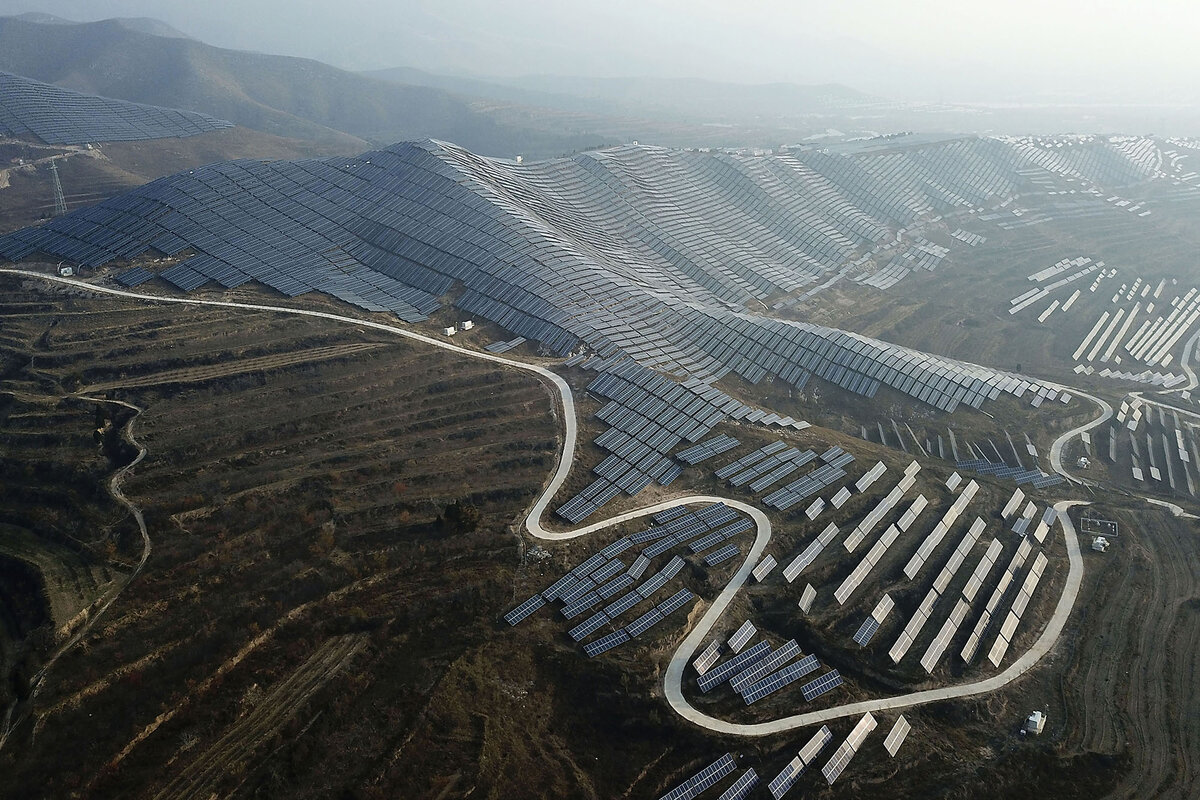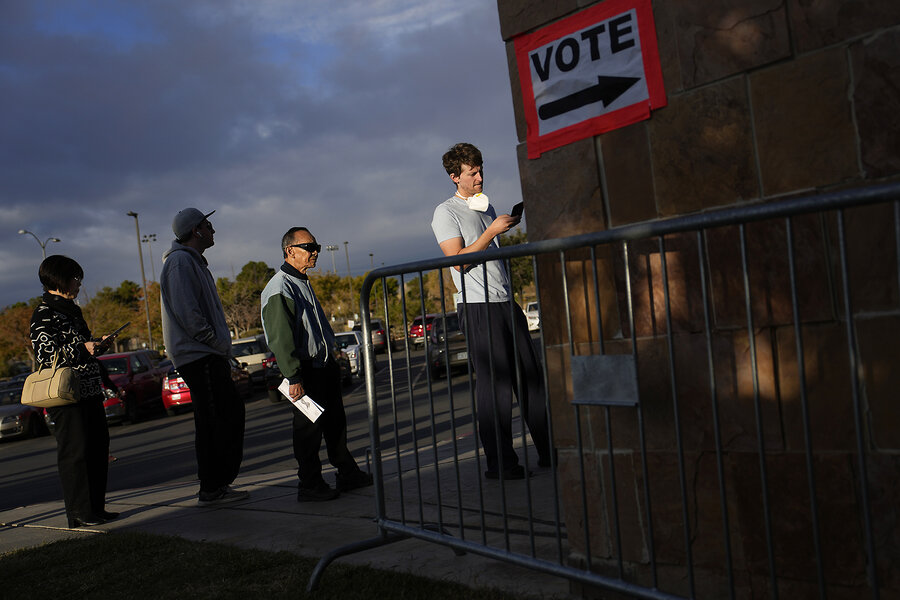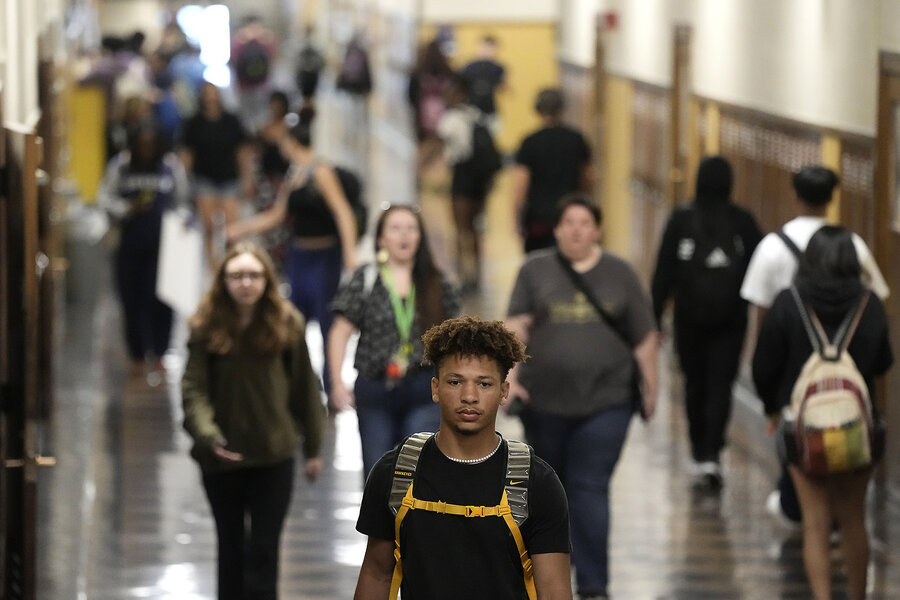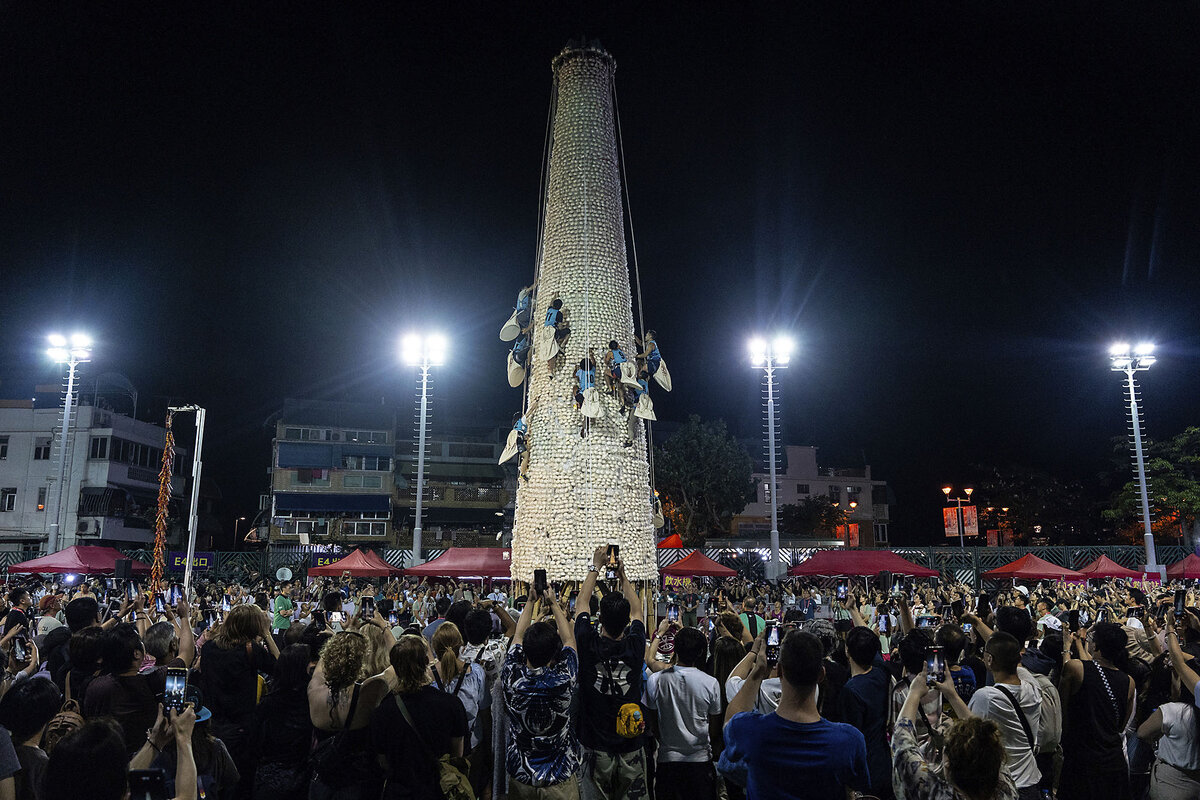- Quick Read
- Deep Read ( 4 Min. )
In Today’s Issue
- What China’s renewable energy boom means for the world
- Today’s news briefs
- Many Americans don’t trust mail-in voting. What can be done?
- Democrats emphasize ‘authenticity’ to take back the House
- Brown v. Board of Education at 70: Promise ... and work to do
- Black expectant mothers need allies. We found some helpmates resurging.
- The Sami people bring on spring – with reindeer and sleighs
Monitor Daily Podcast
- Follow us:
- Apple Podcasts
- Spotify
- RSS Feed
- Download
TODAY’S INTRO
The making of history
Readers of Ken Makin’s columns are familiar with his deep appreciation of history. Today, he reminds us of key players in making that history: everyday actors.
Take Brown v. Board of Education, the landmark case that overturned segregation in U.S. schools and is marking its 70th anniversary. As Ken writes, the work of Thurgood Marshall, who argued the case before the U.S. Supreme Court and would later become its first Black justice, still “rings in history books.” But lesser-known champions helped lay the foundation for that moment – offering models for all of us in the power of stepping up, both to drive progress and to protect it.
Share this article
Link copied.

Help fund Monitor journalism for $11/ month
Already a subscriber? Login

Monitor journalism changes lives because we open that too-small box that most people think they live in. We believe news can and should expand a sense of identity and possibility beyond narrow conventional expectations.
Our work isn't possible without your support.
What China’s renewable energy boom means for the world
China’s booming renewable energy industry may be stirring trade tensions, but it could also accelerate a green transition – in China and elsewhere.

China made historic increases in installations of solar, wind, and other renewable energy in 2023, including adding 216 gigawatts of solar capacity. Experts say China’s rapid adoption of renewable energy is helping move the country – the world’s biggest emitter of heat-trapping gases – toward its climate goals faster than expected.
For example, China has committed to reaching its carbon peak by 2030, but some analysts say its emissions could peak as early as this year, and then start declining. This hinges partly on China’s ability to stabilize its surging energy demand, a significant portion of which is still being met by coal. China’s state-led market dominance in renewables is also provoking trade retaliation, with the United States raising tariffs this week on Chinese solar panels, electric vehicles, and other goods.
Experts say Beijing’s investments in renewable energy benefit many countries that lack such industries, and note that trade barriers imposed by developed countries will create inefficiencies and increase costs, at least in the short term.
“In the long term, [the tariffs] could be somewhat positive because you get more distributed production, which might be more stable,” says Jan Ivar Korsbakken, a researcher in Oslo, Norway. “The issue, of course, is that we don’t have a lot of time.”
What China’s renewable energy boom means for the world
At a sprawling facility in eastern China, engineers and quality control workers in blue and pink uniforms monitor the heavily robotic assembly line for Sungrow Power Supply Co. Ltd.
The firm is one of the world’s biggest producers of solar inverters – equipment critical to making electricity from solar panels usable in grids. And its products are now sold in 170 countries, part of the explosion of China’s renewable energy industry that is fueling trade tension but also facilitating the shift to green power, here and overseas.
Flanked by ceiling-high video screens showcasing Sungrow’s clean energy capabilities, Senior Vice President David Zhao boasts that the company’s total installed capacity has exceeded 500 gigawatts globally. “This is a very great contribution” to the green energy transition, he says at the company’s headquarters in Hefei, China.
Experts say China’s rapid adoption of renewable energy is helping move the country toward its climate goals faster than expected. Last year, China made historic increases in installations of solar, wind, and other renewable energy, including adding 216 gigawatts of solar capacity – more than what exists in the United States.
China – the world’s biggest emitter of heat-trapping gases, accounting for 35% of carbon emissions in 2023 – has committed to reaching its carbon peak by 2030 and carbon neutrality by 2060. But some analysts say its emissions could peak as early as this year, and then start declining. This also hinges partly on China’s ability to stabilize the country’s surging energy demand, a significant portion of which is still being met by coal.
“If the energy demand growth rates normalize and the green energy additions continue, then the first half of this year – so essentially right now – would be the peak,” says Lauri Myllyvirta, senior fellow at the China Climate Hub of the Asia Society Policy Institute. “There is no way to reach the global goals without a much faster peak in emissions in China,” he says. “It’s basically our only hope.”

An energy “tug of war”
While the expansion of renewables is promising, China’s overall climate trajectory remains uncertain. The country remains highly dependent on coal and continues to open new coal-fired plants.
“What has been happening in China is a tug of war between expanding renewables and growing overall power demand,” says Jan Ivar Korsbakken, senior researcher at the CICERO Center for International Climate Research in Oslo, Norway. “China has built out renewables, solar, and wind power generation at just an incredible pace, quite unprecedented.”
But electricity demand has also gone up, driven in part by new high-tech industries such as batteries, he says, illustrating the “very strong forces pulling in different directions.”
This tension could mean that even if China’s emissions do peak early, they are unlikely to drop steeply, and could plateau, Mr. Korsbakken says.
Meanwhile, China’s government-backed dominance of the international market for solar panels, batteries, electric vehicles, and other green energy technologies is sparking trade retaliation. The U.S., Europe, and other advanced economies are concerned that a flood of cheap imports will undermine domestic producers, and possibly create national security risks.
On Tuesday, the Biden administration announced it will double U.S. tariffs on Chinese solar panels to 50% and quadruple those on Chinese electric vehicles to 100%, effectively barring them from the U.S. market.
“China is determined to dominate these industries. I’m determined to ensure America leads the world in them,” President Joe Biden said on X. He also raised tariffs to 25% on Chinese steel and aluminum, and to 50% on Chinese EV batteries and semiconductors.

Beijing responded to the new tariffs by calling the move protectionist and hypocritical, hinting at possible retaliation. The Ministry of Commerce called the tariffs politically motivated and said they violate international trade rules, according to the state-run Xinhua News Agency.
China “will take all measures necessary to defend our legitimate rights and interests,” Foreign Ministry Spokesperson Wang Wenbin said at a press briefing Tuesday. “The fast-growing Chinese new energy industries are what the world economy needs for green transition.”
Green transition roadblocks
Indeed, experts say Beijing’s investments in renewable energy technologies and manufacturing benefit many countries that lack such industries, especially in the developing world. The trade barriers imposed by the U.S. and other developed countries will create inefficiencies and increase costs, at least in the short-to-medium term, says Mr. Korsbakken.
“In the long term, it [the tariffs] could be somewhat positive because you get more distributed production, which might be more stable and lend itself to faster expansion of renewables,” he says. “The issue, of course, is that we don’t have a lot of time.”
One problem with China’s dominance of renewable energy industries is the relatively high level of coal in its electricity mix – meaning its production of solar panels and other clean energy equipment creates more emissions than it would in the U.S. or Europe.
Even as China has outpaced the world in its use of renewable energy, it remains the globe’s biggest producer and consumer of coal, and has undergone a surge in coal consumption since 2020.
And China continues to build more coal-fired power plants, in part to help fill gaps in electricity supply when solar, wind, and hydropower are unavailable. Some Chinese provincial officials favor building coal-fired plants locally to ensure a steady electricity supply and boost gross domestic product for their province, as well as for coal mining as a source of local jobs.
“The biggest challenge for China at the moment is to stop creating more jobs, capacity, and capital tied to coal mining and coal-fired power plants and coal-based steel mills,” says Mr. Myllyvirta. Such expanded coal use, he says, will only “make the transition harder than it needs to be.”

Today’s news briefs
• Israeli hostages: The Israeli military says its troops in Gaza found the bodies of three hostages. All three were killed by Hamas while fleeing the Nova music festival, according to a spokesperson.
• Dow record: The Dow Jones Industrial Average topped 40,000 on May 16, an all-time high. The S&P 500 crossed above its milestone on May 15, topping 5,300 points for the first time.
• Severe storms: Houston’s mayor reports at least four people died in storms May 16. The fast-moving weather system also hit neighboring Louisiana and left more than 215,000 customers there without power.
• Weapons testing: Suspected short-range ballistic missiles are fired off North Korea’s east coast May 17, a day after South Korea and the United States flew fighter jets in a drill North Korea views as a security threat.
• Texas pardon: Gov. Greg Abbott, citing a “stand-your-ground” self-defense law, granted a full pardon May 16 to a former U.S. Army sergeant and Uber driver sentenced to 25 years in prison for fatally shooting a Black Lives Matter protester.

Many Americans don’t trust mail-in voting. What can be done?
Overall, experts say election-related fraud in the United States is extremely rare. And safeguards are in place for mailed ballots. Yet distrust in the system remains high among Republican voters.

- Quick Read
- Deep Read ( 9 Min. )
-
Peter Grier Staff writer
For years and without evidence, Donald Trump has depicted mail-in voting as an example of what he claims is endemic fraud in American elections. An easy way for Democrats, or foreign countries, or unauthorized immigrants to shovel millions of fake, election-flipping votes into the electoral system.
Recently the former president’s message has changed, as campaign advisers worry that President Joe Biden has built a large mail-in advantage in swing states. Absentee and early voting are “good options,” said a post on Mr. Trump’s Truth Social account this week.
But it may be difficult to undo what attacks have already accomplished. Suspicion about mail-in voting has become deeply entrenched among Republicans.
Election officials from both parties say mail-in ballots are a secure and effective means of increasing American participation in elections.
Experts add that they believe trust in mail-in votes – and in U.S. elections overall – can be rebuilt with communication and education. Transparency about how mail-in ballots are distributed, handled, and counted could counteract disinformation that calls the practice into question.
Many Americans don’t trust mail-in voting. What can be done?

“Mailed ballots are corrupt.”
They’re a “disaster” and “out of control.”
They’re “unsolicited, millions being sent to everybody.”
“You’re automatically going to have fraud.”
Since his rise to the heights of politics nine years ago, former U.S. President Donald Trump has continuously denounced mail-in voting as a concrete example of what he claims is endemic fraud in American elections.
Without evidence, he has depicted mail voting as an open portal in many states, an easy way for Democrats, foreign countries, or unauthorized immigrants to shovel millions of fake, election-flipping votes into the electoral system.
Recently his message has changed, as campaign advisers worry that President Joe Biden has built a large mail-in advantage in swing states. Absentee and early voting are “good options,” said a post on Mr. Trump’s Truth Social account this week.
But it may be difficult to undo what attacks have already accomplished. Suspicion about mail-in voting has become deeply entrenched among Republicans. Sixty-two percent of GOP and GOP-leaning voters oppose allowing people to vote using mailed ballots without an excuse, according to a 2023 Associated Press/NORC Center for Public Affairs poll. Among Democrats, the opinion is almost reversed: About 70% support no-excuse mail voting.
Election officials from both parties say mail-in ballots are a secure and effective means of increasing American participation in elections. It is true that many states relaxed restrictions on mail-in use for the 2020 election. But that was due to the COVID-19 pandemic, officials say, not a conspiracy to tilt the vote for Mr. Biden.
Experts add that they believe trust in mail-in votes – and in U.S. elections overall – can be rebuilt with communication and education. Transparency about how mail-in ballots are distributed, handled, and counted could counteract disinformation that calls the practice into question.
Voting used to happen “in view of the public,” says Derek Lyons, president of Restoring Integrity and Trust in Elections and a former counselor to the president in the Trump administration. With voting by mail, a process that takes place in private, “even if it’s all happening perfectly, people have to be able to trust it.”

How mail-in voting has grown, in all 50 states
Eight states and Washington, D.C., allow all elections to be conducted entirely by mail. Beyond that, states allow a varying amount of voting by mail, from permitting counties to opt in to allowing mostly mail elections for small jurisdictions.
All states, though, offer some degree of mail voting, whether it be mailed absentee ballots for voters who cannot make it to the polls on Election Day or no-excuse-needed mail ballots. Twenty-eight states allow any voter to request and cast a mail ballot.
While mail voting isn’t new across the board, it is new in some jurisdictions, or newly expanded. During the pandemic, nearly every state increased its use of mail-in voting, and many of those expansions remain today.
So for people in areas where voting by mail was less common prior to the pandemic, public perception may still be catching up to the new reality of their electoral systems.
In states where voting by mail is newer, “a lot of people don’t want to give up that experience of voting in person and that sense of satisfaction and even that sense of community of being there physically with other voters that comes with going to the polls,” says Michael Morley, a law professor and election law expert at Florida State University.
Nationally, use of mail voting more than doubled from the 2016 to the 2020 presidential elections, from 20% to 43% of ballots cast. In the 2022 midterms, held as the COVID-19 pandemic was abating, mail votes fell back to 31% of the total.
Safeguards against fraud for mailed ballots
In general, voters must request a mail ballot. In a handful of states, ballots are automatically mailed to registered voters. Any ballot that’s returned is cross-checked with details on the state’s voter rolls, including matching the signature on the ballot with the signature on file for that voter. Ballots are disqualified for any number of discrepancies, including if the signatures differ.
Every person on a state’s centralized voter list who is sent a mail ballot is flagged so that they cannot vote twice – once via the post office, once in person. Many states print bar codes on ballot envelopes that allow voters to track their ballot and see whether it has been received. The codes are also helpful in post-election audits.
Ballot design can serve as an additional safety measure. To be counted, fake ballots would need to mimic the size, print, paper weight, envelope, and other characteristics of genuine ballots. Yet those can differ county to county, and election to election.
In addition some states have outlawed the gathering and submitting of mail-in ballots by third parties, known as “ballot collecting” or as “ballot harvesting” to its opponents. The theory behind the bans is that the practice is particularly vulnerable to vote tampering.
How distrust has risen
In the U.S. electorate as a whole, trust in mail-in voting has declined somewhat in recent years. Just prior to the 2020 election, 56% of voters were strongly or somewhat in favor of allowing people to vote by mail instead of in person without requiring them to give a reason, according to the AP-NORC survey. A few months after the 2022 midterms, that measure had slid to 47% of voters.
But that change was driven largely by Republicans souring on the practice. In 2023, 24% of GOP voters were strongly or somewhat in favor of no-reason mail-in voting, as opposed to 71% of Democrats and 47% of independents, according to AP-NORC numbers.
The irony is that mail-in voting was established first in Western states, many of which now trend conservative. Their wide-open spaces and low population density can make getting voters to the polls on a single Election Day more difficult than in the relatively crowded East.
“Until 2020, voting by mail was embraced by both parties almost equally,” says David Becker, executive director of The Center for Election Innovation and Research.

Two aspects of mail-in ballots raise particular concern among critics. One is that the ballot is cast outside the public eye, making it easier for someone to coerce the voter to vote a particular way, or for an impersonator to cast the ballot to begin with. The second is that their delivery method is not rock-solid secure, raising concerns about the vote being tampered with or lost entirely.
Overall, election-related fraud is “very, very rare,” says Professor Morley. Yet experts generally agree that fraud related to mail-in voting is more frequent than in-person voting abuses.
In 1997, cases involving absentee and mail-in ballot fraud resulted in well-publicized convictions in Georgia and Florida. More recently, in Bladen County, North Carolina, political operative Leslie McCrae Dowless paid people to collect absentee ballots from voters’ doorsteps, and then fill in votes and forge signatures in an attempt to stuff the box for GOP candidate Mark Harris in a 2018 congressional election.
It is difficult to tamper with ballots on a scale large enough to have an effect on anything but elections with a small number of voters, however. In state or national elections, even close finishes often involve margins of hundreds or thousands of votes.
It is easy to notice discrepancies of that size.
“If you want to become a five-to-10-year tenant of the federal prison system, committing bulk mail voting fraud is a really great way to do it,” says Mr. Becker.
The polarization of a voting method
The most outspoken critic of mail-in ballots in the United States is, of course, former President Trump. He railed against the practice during his 2016 campaign, but his anti-mail-in rhetoric exploded in intensity as the 2020 presidential election neared. In July 2020, then-President Trump suggested in a social media post that the upcoming vote be postponed, since “Universal Mail-in Voting” would make it “the most INACCURATE & FRAUDULENT Election in history.”
Subsequently he publicly warned that millions of mail-in ballots would be printed by foreign countries, resulting in a “rigged” election, and that Democrats were mailing out “80 million unsolicited ballots” so they could “harvest” votes to elect Mr. Biden.
Those charges were false. There remains no documented evidence of widespread fraud in 2020. Election officials from both parties have testified that the vote was free and fair, as have numerous former Trump administration appointees. The Trump campaign lost virtually every court case it filed in the wake of Mr. Trump’s loss.
But Mr. Trump’s attacks found a receptive audience among his supporters. Since 2020, he has continued to denounce the election results in general and mail ballots in particular.
Thus attitudes toward mail-in voting are now politically polarized, like attitudes about COVID-19 vaccines, climate change, and abortion. Voters’ opinions are based not just on their personal views but also on the attitudes of the leaders of their political team.
That makes changing them doubly difficult. What might otherwise be grumbling discontent has been raised to party dogma.
“Having a presidential candidate refuse to accept the election’s outcome intensified everything, added whole new dimensions to everything,” Professor Morley says.

How to build trust in voting by mail
As the nation heads into the 2024 election, the surprise is that many state and national Republican officials would like Mr. Trump to reverse his message and plug GOP participation in mail-in balloting.
They are looking for any edge they can gain against a Democratic Party that has long embraced the practice.
In April, Donald Trump Jr., the former president’s son, was featured in two ads promoting mail-in voting that ran in Pennsylvania, a crucial battleground.
In May, the former president printed a pro-mail-in post on his Truth Social account. “ABSENTEE VOTING, EARLY VOTING, AND ELECTION DAY VOTING ARE ALL GOOD OPTIONS,” said the post.
But in person, Mr. Trump continues to deliver a mixed message. At a recent rally in Wisconsin, the state’s GOP chairman and other officials took the stage first and urged attendees to embrace early voting, whether in person or by absentee ballot. Mr. Trump, however, hammered the Wisconsin voting system when he took the stage, saying he would have won the 2020 election in the state if not for fake absentee ballots in Milwaukee.
“We won the state by a lot,” Mr. Trump told the crowd, though in reality he lost it to Mr. Biden by some 21,000 votes.
Whether Republicans will change their minds about mail-in voting now remains to be seen. In 2022, the percentages of GOP voters who used the option did tick upward somewhat.
For election officials, sticking to basics might help with voters suspicious of the sudden expanse of the practice in the pandemic years, says Mr. Lyons.
“Test the machines, secure the drop boxes, verify identities, send ballots only to people who asked for them,” he says. “These are simple things that you can do to shut down the ability for people to call the election into question after the fact.”
Other experts emphasize the need for education.
Over the years, election officials have seen their roles expand from essentially event managers, to include the need to be information technology specialists, then cybersecurity experts, and now outreach coordinators, says Wendy Underhill, director of elections and redistricting at the National Conference of State Legislatures.
“They’ve found themselves spending more time on the education process, and they are always welcoming to groups” who want to learn about ballot design and printing, and then how ballots are collected, processed, counted, and collated, says Ms. Underhill.
“The communications piece is just more prominent than it was” a decade ago, she says.
That outreach is key, because most people simply feel comfortable with what’s familiar, says Ms. Underhill, whether that’s mail or in-person voting.
If people have doubts about election integrity generally, Scott Schwab, secretary of state of Kansas, has a clear answer: “Work the polls.”
Hands-on experience as a voting station volunteer is “the biggest advocate we have” to dispel doubts about whether U.S. elections are secure, says Mr. Schwab.
Election education has always been an important responsibility of election officials, says Mr. Schwab. But as times change, “the way we do it has changed.”
Mr. Schwab, who is also the president of the bipartisan National Association of Secretaries of State, spends a lot of time explaining election processes and supporting outreach campaigns that do the same. The video explanations, flyers, and information sessions election officials host across the country are all important.
But there’s no substitute for actually working an election. When people do that, they report being surprised by the complexity of elections and the levels of security, he says.

Monitor Breakfast
Democrats emphasize ‘authenticity’ to take back the House
At a Monitor Breakfast, Democratic Rep. Suzan DelBene of Washington state talks about the value of different perspectives and her party’s chances to retake the U.S. House this fall.

- Quick Read
- Deep Read ( 4 Min. )
Despite a challenging Senate map and former President Donald Trump leading in several swing state polls, the upcoming U.S. House elections offer a glimmer of hope for the Democratic Party.
Rep. Suzan DelBene of Washington state, chair of the Democratic Congressional Campaign Committee (DCCC), is optimistic about her party’s chances to retake the U.S. House this fall. Not all Democratic campaigns are the same, she notes.
“There are some places where we might overlap,” said Ms. DelBene at a Monitor Breakfast with reporters on Friday. ”But we also have a lot of races in places where you’re not going to see as much focus on the presidential side.”
To claw back the Republicans’ four-seat majority, Ms. DelBene said that she sees an “incredible opportunity” in the 16 seats now held by Republicans in districts that President Joe Biden won in 2020, as well as seats in New York and California. The DCCC has also identified 29 “front-liners” (Democratic incumbents in purple districts) and 20 “red-to-blue” candidates (those hoping to flip Republican seats) to support.
Democrats emphasize ‘authenticity’ to take back the House

Despite a challenging Senate map and former President Donald Trump leading in several swing state polls, the upcoming U.S. House elections offer a glimmer of hope for the Democratic Party.
Rep. Suzan DelBene of Washington state, chair of the Democratic Congressional Campaign Committee (DCCC) that recruits candidates and supports incumbents facing competitive reelections, is optimistic about her party’s chances to retake the U.S. House this fall. And while she says she is confident that President Joe Biden will win reelection, Ms. DelBene acknowledges that not all Democratic campaigns are the same.
“Our races are unique races,” said Ms. DelBene at a Monitor Breakfast with reporters on Friday. “There are some places where we might overlap ... but we also have a lot of races in places where you’re not going to see as much focus on the presidential side.”
To claw back the Republicans’ current four-seat majority, Ms. DelBene sees an “incredible opportunity” in the 16 seats now held by Republicans in districts that Mr. Biden won in 2020, as well as seats in the blue states of New York and California. Of the DCCC’s map focusing on 65 races, it has also identified 29 “front-liners” – Democratic incumbents in purple districts – and 20 “red-to-blue” candidates hoping to flip Republican seats.
Ms. DelBene, who has represented a district north of Seattle since 2012, was handpicked by House Minority Leader Hakeem Jeffries to oversee the DCCC after what many saw as a mismanagement of competitive races in 2022. Colleagues characterize her as a thoughtful leader, who listens before making a decision.
“I spent a lot of time running organizations before I became a member of Congress, so I approached the DCCC similarly,” says Ms. DelBene. “As someone who came to Congress representing a swing district ... I know how important it is to make sure that we not only have great candidates but make sure that folks are running the races that are authentic to them so it’s not so much a cookie-cutter mentality.”
Following are more excerpts from the breakfast, lightly edited for clarity:
How are you advising candidates to navigate the Israel-Gaza issue? It’s obviously divided the party.
Have an authentic voice, and talk about how you feel on issues. People can tell if someone’s scripted and not really talking about their feelings. And, frankly, call out the cynicism of Republicans. This most recent piece of legislation they put on the floor on Israel had nothing to do with helping to address an issue. It was a political move on their part. Highlight that. Republicans continue to put their politics first.
How do you plan to reach young voters?
You’re going to see a lot of movement towards digital media, social media, etc., because that’s where a lot of people get their information. It’s really important not only that we engage where people are getting their information, but [that] people are engaging with young voters ... to make sure that people understand what’s at stake. The issues that young people care about are very similar. Economic opportunity is number one across all age groups when we talk to folks across the country.
How are you coaching front-liners in red districts to signal to those homeless former Republican voters that the Democratic tent is big enough for them?
We have five Democrats in seats that President Trump won in 2020: Marcy Kaptur [of Ohio], Marie Glusenkamp Perez [of Washington], Mary Peltola in Alaska, Matt Cartwright in Pennsylvania, Jared Golden in Maine – all who have won because they are trusted, authentic candidates who represent their region. People want a representative they can trust, not always one who is going to agree with everything.
Have those front-liners been able to take those viewpoints from their districts and get some traction with more diverse viewpoints within the Democratic caucus?
I do think that you’re a better legislator when you hear differing points of view and are forced to try to come up with what the right solution is.
It would be great if we were having those healthy bipartisan debates, too. ... It’s been really disappointing to see the end of moderate Republicans. There just aren’t any left in Congress. They got beat in primaries. They’ve resigned and left. We’ve ended up in a place where the Republican Party, and definitely in the House, has been taken over by the most extreme members of their caucus.
I’d love to see us get back to a place where we have folks who are willing to do that on both sides of the aisle. But frankly, as long as Republicans seem to think that their own role is to follow the word of Donald Trump and not ever be able to express a differing point of view, then we need to show the American people that we reject that. They’re not going to be representing us. And they’re not going to be holding the gavels in the House of Representatives.

Commentary
Brown v. Board of Education at 70: Promise ... and work to do
On the 70th anniversary of the Brown v. Board of Education decision, our commentator weighs the promise that decision still offers for students against the realities of what their schools look like today.

- Quick Read
- Deep Read ( 5 Min. )
I was four years into my tenure at a Black-owned newspaper when the city of Augusta, Georgia, voted to lift a decades-old desegregation order back in 2013.
I was skeptical of the move because the promise of progressivism in education had not been fulfilled, evidenced by middling test scores and a literal erasure of the city’s Black educational past.
I feel a similar ambivalence on the 70th anniversary of the Brown v. Board of Education decision from the U.S. Supreme Court that presumably made integration the law of the land. At once, there’s the promise of equity in education for students, regardless of race or economic background. On the other hand, there are the realities of resegregation, which paint a far more grim picture.
American society is largely removed from the staunch physical violence of the Civil Rights Movement, but segregationist attitudes and policies are having an overt effect on schools once more. An April report from the Civil Rights Project at the University of California, Los Angeles, offers a snapshot of the current environment: The proportion of intensely segregated schools rose to 20%, nearly tripling over the past 30 years.
Brown v. Board of Education at 70: Promise ... and work to do
I was four years into my tenure at a Black-owned newspaper when the city of Augusta, Georgia, voted to lift a decades-old desegregation order back in 2013. I was skeptical of the move because the promise of progressivism in education had not been fulfilled, evidenced by middling test scores and a literal erasure of the city’s Black educational past.
Less than a month after the order was lifted, the school system in Augusta acknowledged plans to tear down the Cauley-Wheeler building, a hallowed and historical structure on the campus of Lucy Craft Laney High School. The house was the last remaining structure from the Haines Normal and Industrial Institute, which Ms. Laney founded in 1886 to educate Black children. There were various times of the year that I would take photos of events on Laney Walker Boulevard, with alumni and enthusiasts in attendance, but when it came to saving a piece of history, one could hear a pin drop in comparison.
I feel a similar ambivalence on the 70th anniversary of the Brown v. Board of Education decision from the U.S. Supreme Court that presumably made integration the law of the land. There’s the promise of equity in education for students, regardless of race or economic background. On the other hand, there are the realities of resegregation, which paint a far more grim picture.
American society is largely removed from the staunch physical violence of the Civil Rights Movement, but segregationist attitudes and policies are having an overt effect on schools once more. An April report from the Civil Rights Project at the University of California, Los Angeles, offers a snapshot of the current environment: The proportion of intensely segregated schools rose to 20%, nearly tripling over the past 30 years.

Robert Greene II, a history professor at Claflin University, a historically Black university in Orangeburg, South Carolina, says the legacy of Brown is “that of continued promise.” But, there’s more to it than that.
“Memorializing Brown v. Board, while also acknowledging the work that remains to be done in education, is critical if we’re going to see positive change in our society,” Dr. Greene writes in an online interview. “Already, there are far too many prominent leaders calling for a retreat from the ideals of Brown v. Board. Part of why we need to keep this alive is to make sure that the legacy becomes real, substantial reform in education.”
In terms of the Black experience, reform was far more revolutionary and hard-fought. While Topeka, Kansas, provided the backdrop for the Brown showdown, dreams of equity in education took root in Clarendon County, South Carolina, in the 1940s. It started with a handful of Black families who aspired to send their kids to school, but the county only bused white children.
Levi Pearson was the first to board up his truck to transport children to and from school, but that only scratched the surface of the injustice they experienced, according to author Claudia Smith Brinson, who writes: “South Carolina spent $221 annually for each white student, $45 for each Black student. The schools serving 2,296 white children in Clarendon County were worth $390,600; the schools serving 6,081 Black children were worth $64,285.”
“Separate but equal,” the law insisted. This put the Pearsons in contact with legendary future Supreme Court justice Thurgood Marshall, who was the NAACP’s special counsel at the time. He filed a suit on the Pearsons’ behalf, but it was dismissed. The Pearsons’ white neighbors were violent, but Levi often said that “I believe God wants me to do it. God wants me to make the sacrifices.”

There’s a direct lineage between the champions of Clarendon County and today’s efforts to teach a history that is under siege by local and state governments. Dr. Greene is the lead instructor at the Modjeska Simkins School, which is named for a pioneering educator and activist who helped write the declaration of equality for the lawsuit that called for equal access in Clarendon County.
History knows much about Justice Marshall, whose call to desegregate schools “with all deliberate speed” rings in history books and educational lore. Heroes such as Ms. Simkins, Rev. Joseph DeLaine, and Harry and Eliza Briggs are not as well known. Mr. Briggs was the lead plaintiff of Briggs v. Elliott, the first of five cases that laid the groundwork for Brown.
Amidst this milestone celebration of Brown v. Board, we should do a better job of not just appreciating the everyday people who made the movement, we should also be mindful of the finer details in education. That goes beyond the noise of pitting public and private schools against each other, or incessant and ahistorical railings about critical race theory. For years, people have expressed concerns about a “literacy crisis” in education. Perhaps it’s a challenge of malnutrition; specifically, students who arrive at school unfed. Which again puts economic disparities under rightful scrutiny.
Less than five minutes from the Board of Education building in Augusta there’s a cyber center named after a former governor that has garnered praise for being a forward-thinking effort. There’s a historical marker in front of the parking deck that is not as celebrated – a recognition of Ware High School, which opened in 1880 as the first African American high school in Georgia. The school was closed for financial reasons after the Plessy v. Ferguson decision in 1897, which argued the “separate but equal” ideology that enforced legal segregation.
I ride by that marker twice a week, and when I do, I flash back to the Cauley-Wheeler building, to homecoming parades, to all of the joys and sufferings that make up the constitution of education. And out of the name “Ware,” I am mindful to be aware of what’s going on in education and civics in general. I understand now that living documents alone aren’t enough to preserve the civil rights legacy. Those of us who are living must do our part as well.

Podcast
Black expectant mothers need allies. We found some helpmates resurging.
History and experience have left some Black women in the United States feeling underserved by the medical system when it comes to maternal health. Can birth doulas help restore a sense of agency and control? Our writer explored that question, then joined our podcast to discuss what he learned.

As life events go, pregnancy and childbirth rank high as ones requiring support – familial, institutional, societal. Without it, a sense of comfort can ebb. That can have negative effects.
In the United States, Black women in particular have historically faced a shortfall of support from the health care system. That has contributed to relatively high rates of maternal and infant mortality.
The Monitor’s Cameron Pugh looked into signs that the role of a quiet, long-time obstetric helpmate – the birth doula – may be having a moment.
“When you drill down into it, the entire issue is about trust,” Cameron says on our “Why We Wrote This” podcast. The story he recently reported looked into the world of these patient advocates – at their motivations and potential for helping in culturally appropriate ways.
“Many of the doulas I talked to spoke about having children of their own and not having positive experiences,” he says, “and how they wanted to provide better experiences for other women.”
“There needs to be broader structural change and … all of these different things that will lead to really measurable progress,” Cameron says. “But I think doulas will end up being a pretty significant part of that.” – Clay Collins and Mackenzie Farkus
Find story links and a transcript here.
Where Black Women Reclaim Power

In Pictures
The Sami people bring on spring – with reindeer and sleighs
Spring is a time of rejuvenation. The Earth may be slow to warm in the Arctic, but the Sami people find renewal in their faith.

- Quick Read
- Deep Read ( 2 Min. )
-
By Avedis Hadjian Contributor
The Sami live in a frigid expanse stretching across the northern reaches of Norway, Sweden, Finland, and the Kola Peninsula in Russia. Since the 1970s, the weeklong Easter festival in Kautokeino, Norway, has attracted Sami and a growing number of non-Sami participants. On Easter, Kautokeino Church fills with worshippers in their finest brightly colored gákti, or traditional clothing.
“Spring has always been an important time in such a climate-wise, dramatic world as the Arctic,” says Ánde Somby, a traditional joik singer and associate professor of law at the University of Tromsø.
For the Sami, the heart of the Easter celebration is the joik, the singing with which they honor the things that mean the most to them. “Joik” is also a transitive verb. You joik winter, your love, or a pack of wolves.
The joik, and Sami culture generally, for a long time had been endangered under the fornorsking, or Norwegianization, policy. Yet with the Easter festival, the Sami are experiencing a “renaissance,” Mr. Somby says.
Expand this story to see the full photo essay.
The Sami people bring on spring – with reindeer and sleighs
In the Sapmi, the Arctic homeland of the Sami people, the end of winter isn’t announced by green sprouts or the cheery chirps of birds. Instead, the Sami sing folk songs around a roaring fire and race reindeer in the snow.
The Sami live in a frigid expanse stretching across the northern reaches of Norway, Sweden, Finland, and the Kola Peninsula in Russia. Since the 1970s, the weeklong Easter festival in Kautokeino, Norway, has attracted Sami and a growing number of non-Sami participants. Although the Sami people’s relationship with Christianity has been contentious at times, Easter has become a popular spring feast, when Kautokeino Church fills with worshippers in their finest brightly colored gákti, or traditional clothing.
“Spring has always been an important time in such a climate-wise, dramatic world as the Arctic,” says Ánde Somby, a traditional joik singer and associate professor of law at the University of Tromsø.
The heart of the celebration is the joik, the singing with which the Sami celebrate the things that mean the most to them. “Joik” is also a transitive verb. You joik winter, your love, or a pack of wolves.
The joik, and Sami culture generally, for a long time had been endangered under the fornorsking, or Norwegianization, policy. Yet with the Easter festival, the Sami are experiencing a “renaissance,” Mr. Somby says.
“Soon, the Easter celebration will be out of Christianity and missionaries’ hands,” he adds, noting “how much inspiration and creative power the youth display during the Easter festival.”




Other headline stories we’re watching
(Get live updates throughout the day.)The Monitor's View
New buzz on the ball court
- Quick Read
- Deep Read ( 2 Min. )
-
By the Monitor's Editorial Board
Limit-shattering women too often require male reference points to lodge in public thought. Yet that may now be about to change. The reason: the star-bursting arrival of what already looks like a paradigm-shifting cultural phenomenon.
Google it. The Caitlin Clark effect.
The most talked-about athlete in America right now is female. Caitlin Clark strode into the Women’s National Basketball Association this week clothed in superlatives. The highest scorer – male or female – in the history of the NCAA. The No. 1 draft pick.
Her impact on the court draws comparisons to male players. She shoots 3-pointers like Steph Curry. Yet her “effect” resides more off the court, in the power of sport to promote equality through new views of human achievement and the universal qualities that enable it.
“There is something that happens in the way that men view women when women are seen to perform under pressure at a really high level physically,” said sports columnist Sally Jenkins in a Washington Post podcast following Ms. Clark’s home opener in Indiana on Thursday night. “There’s a credibility. ... That physical competency and emotional competency under pressure, it makes it easier for men to envision women driving aircraft carriers on a midnight shift.”
New buzz on the ball court

Remember Lynette Woodard? How about Katherine Johnson or Nona Gaprindashvili?
Limit-shattering women too often require male reference points to lodge in public thought. Ms. Johnson is to Albert Einstein in physics as Ms. Gaprindashvili is to Garry Kasparov in chess. Yet that may now be about to change. The reason: the star-bursting arrival of what already looks like a paradigm-shifting cultural phenomenon.
Google it. The Caitlin Clark effect.
The most talked-about athlete in America right now is female. Caitlin Clark strode into the Women’s National Basketball Association this week clothed in superlatives. The highest scorer – male or female – in the history of the NCAA. The No. 1 draft pick.
Her impact on the court draws comparisons to male players. She shoots 3-pointers like Steph Curry. Yet her “effect” resides more off the court, in the power of sport to promote equality through new views of human achievement and the universal qualities that enable it.
“There is something that happens in the way that men view women when women are seen to perform under pressure at a really high level physically,” said sports columnist Sally Jenkins in a Washington Post podcast following Ms. Clark’s home opener in Indiana on Thursday night. “There’s a credibility. ... That physical competency and emotional competency under pressure, it makes it easier for men to envision women driving aircraft carriers on a midnight shift.”
Ms. Clark follows a handful of pioneering women who used their athletic prowess to compel social change. Tennis great Billie Jean King and soccer star Megan Rapinoe championed human dignity in their advocacy for equal pay and LGBTQ+ rights. Serena Williams and gymnast Simone Biles broke racial barriers and voiced compassion for those struggling with mental health.
Now comes Ms. Clark. She is already changing the economics of the game by forcing scrutiny on the unequal salary structures of men’s and women’s professional basketball. Branding and ticketing companies are changing their business models to accommodate skyrocketing demand. Leadership experts are studying her game for new insights into what brings success.
More importantly, as Ms. Jenkins noted, she is erasing the notion that athletic excellence has different levels based on gender. She is “one of the best college basketball players to ever play,” Patrick Mahomes, quarterback for the Kansas City Chiefs, posted on X back in February. In a poll by The Athletic last month, players in the NBA, the men’s top league, ranked Ms. Clark their second-favorite athlete in any other professional sports league, male or female. They didn’t stop there. Five other female basketball players earned votes – and respect – from their male counterparts.
Back to Lynette Woodard. For more than 40 years before Ms. Clark came along, she was the top-scoring female college basketball player of all time. She was often remembered in the same sentence with the men’s top scorer, Pete Maravich. Now she is compared to the woman who broke her record. Perhaps one day, the next Steph Curry will be called the Caitlin Clark of his generation.

A Christian Science Perspective
Each weekday, the Monitor includes one clearly labeled religious article offering spiritual insight on contemporary issues, including the news. The publication – in its various forms – is produced for anyone who cares about the progress of the human endeavor around the world and seeks news reported with compassion, intelligence, and an essentially constructive lens. For many, that caring has religious roots. For many, it does not. The Monitor has always embraced both audiences. The Monitor is owned by a church – The First Church of Christ, Scientist, in Boston – whose founder was concerned with both the state of the world and the quality of available news.
Conquering little aggravations with generous, Christly love
- Quick Read
- Read or Listen ( 4 Min. )
-
By Toni Wengler
A spiritual view of life shows us it’s always possible to express healing compassion toward others.
Conquering little aggravations with generous, Christly love
A close friend and I were to meet for breakfast. It was a special occasion because we saw each other only twice a year. I arrived at the café early and sat at a table by the window.
It was a quiet place, and I cherished the opportunity to spend time praying and reflecting on spiritual ideas from that week’s Bible Lesson in the “Christian Science Quarterly.” But after sitting in the café for about 20 minutes, I realized no one had come to take my drink order or offer a menu. I began to feel irritated. I saw that the server was angrily confronting staff members, which made the atmosphere in the room uncomfortable.
Isn’t feeling irritated how many conflicts start? Having been in situations like this before, I knew that if I allowed the agitation to fester, things could escalate. I’d feel justified in reacting in an unloving way. But I was not about to let that happen. Instead of springing out of my chair to speak to someone on staff, I opted to continue in prayer.
I’d learned that those nasty little feelings of irritation that would throw us off balance, that tempt us to indulge in self-justified intolerance of one another, can be swiftly seen as thoughts that are not in line with God’s government of His creation. Man, which includes all of us in our true nature as God’s spiritual offspring, is under the influence of the spiritual law of God, good, only. Turning to God and recognizing this spiritual reality opens thought to the divine influence, the Christ, exemplified in the life and healings of Jesus. Another’s manner cannot then make us miserable. And furthermore, we can see the truth that each one of us elegantly and beautifully reflects God.
The ideas that I had been praying with earlier were very helpful. One citation I had read from the textbook of Christian Science, “Science and Health with Key to the Scriptures” by Mary Baker Eddy, says, “Harmony in man is as beautiful as in music, and discord is unnatural, unreal” (p. 304).
The true, spiritual man is created in God’s image. Spiritual man reflects the harmony and infinite qualities or “notes” of divine Soul. Whatever we experience humanly that is discordant or not in tune with the facts of God’s government must yield to an understanding of the spiritual facts. And this understanding, gained by listening to God, brings healing. God’s reign of harmony becomes naturally apparent in our lives, just as beautiful music is heard as the musician understands and practices the laws of music.
We have a glorious opportunity to love God with our whole heart and to express love and compassion toward others. This is at the core of what Christ Jesus taught. Compassion embraces another in a sweet song of love.
However, one can’t be naive or apathetic about the disturbances that can cause fear and division among people. We can actively pray to see the powerlessness of the notion that God is not supreme. As we do this, as we stand strong with the truth of God and man, we are prepared to give a “soft answer” that “turneth away wrath” (Proverbs 15:1) and obey Christ Jesus’ command to love one another. Nothing and no one can take from us our joy and dominion! And this truth enables us to experience grace and dignity in our lives.
My friend arrived at the café. After a while our server approached us, exuding an air of anger and frustration. She practically threw our menus on the table! Without saying a word, she then walked away. My friend and I looked at each other, and I assured her that our time together could not be ruined in any way. Instead of going down the road of self-righteousness, we agreed to pray together, reaching out to God to see that everyone was included in our prayers. We took a spiritual stand, expecting to witness harmony.
The server soon returned to take our order. Now lightheartedness seemed to infuse her every step. Her initial misery had yielded, dissipating into a newfound sense of joy and vitality, accompanied by an apologetic smile. She confessed to having had a sleepless night and dreading coming to work, and added that she had become very angry about her job. What a joy to see her turnaround! My friend and I smiled.
No matter how small a situation might seem, affirming God’s law of harmony contributes to seeing the promises of the kingdom of heaven, the reign of harmony, fulfilled on earth.
While driving home, I was reminded of a message that Mrs. Eddy included in her “Miscellaneous Writings 1883-1896”: “We should remember that the world is wide; that there are a thousand million different human wills, opinions, ambitions, tastes, and loves; that each person has a different history, constitution, culture, character, from all the rest; that human life is the work, the play, the ceaseless action and reaction upon each other of these different atoms. Then, we should go forth into life with the smallest expectations, but with the largest patience; with a keen relish for and appreciation of everything beautiful, great, and good, but with a temper so genial that the friction of the world shall not wear upon our sensibilities; with an equanimity so settled that no passing breath nor accidental disturbance shall agitate or ruffle it; ...” (p. 224).
We can embrace each day as a glorious opportunity to be a transparency for God’s love, which enriches not only our lives but also the world around us.
Adapted from an article published in the April 8, 2019, issue of the Christian Science Sentinel.

Viewfinder
Bun fun

A look ahead
We hope you’ve enjoyed the Monitor Daily this week. On Monday, keep an eye out for Anna Mulrine Grobe’s piece about how, as Russia’s Kharkiv offensive has stepped up, calls are increasing for the United States and other countries to lift their restrictions on Ukraine using its long-range missiles to hit Russian territory.




